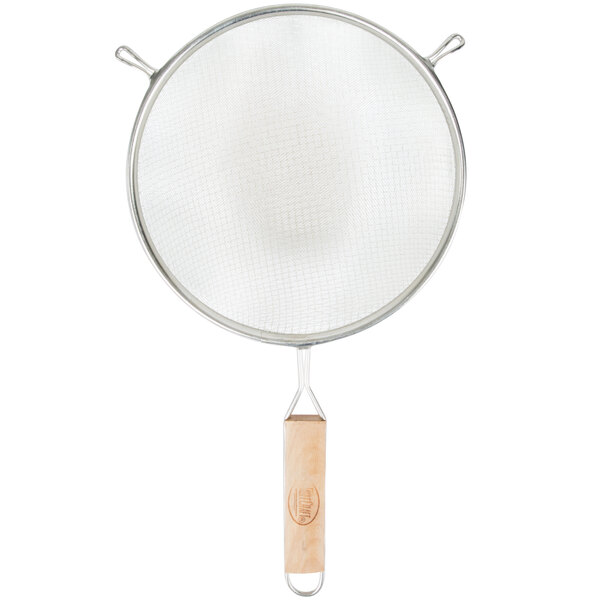For this page's purpose, when I refer to sifting, I mean sifting larvae from frass and other waste. I use the same tools to separate (sort) the larvae by sizes. Sorting is not an exact science in my farm, nor does it need to be for my purposes.
The tool I use most often in the mealworm or superworm farm is a plastic colander with narrow slits I purchased from Dollar Tree.
(Dollar General has a similar colander.)
However, other tools work for sifting and sorting. I have found them useful, though I have modified them to fit my needs better. (Example: I made a DIY sifter from a grease splatter screen, fitted into a round cake carrier lid, and adhered with caulk.)
However, other tools work for sifting and sorting. I have found them useful, though I have modified them to fit my needs better. (Example: I made a DIY sifter from a grease splatter screen, fitted into a round cake carrier lid, and adhered with caulk.)
Fine Mesh Kitchen Strainer:
 I have two strainers I use for separating very small larvae from frass. These are common household strainers. One has slightly bigger holes than the other, so, I use it for separation of small and tiny larvae from frass.
I have two strainers I use for separating very small larvae from frass. These are common household strainers. One has slightly bigger holes than the other, so, I use it for separation of small and tiny larvae from frass.

Plastic colander with narrow slits:
To sift and sort mealworm (tenebrio molitor) beetles, dead and alive, I use this slotted colander. It is also good to sift superworms or large mealworms, exceeding 1" or fat. I sift the entire drawer of molitor beetles with substrate and put the dead and living beetles in a separate container (a kitty litter pan). Then pouring the beetles on and off egg crate; the living beetles will hold on to the egg crate and can be shaken off into a new drawer of bran. [Pupae are removed to their own container.] Once separated, the dead beetles are composted or thrown into the pasture.
How and when I use sorting tools:
Although I don't have a schedule for sifting or sorting; I go by perceived size. [A] When a drawer of mealworms has deep frass build up of 1-1.25"; [B] Mealworms reach 3/4 to 1" long and begin to pupate at a rate of ten or more per day; [C] Superworms need sifting for sell or to relieve crowding, whereas, the largest are removed to another container.
 I have two strainers I use for separating very small larvae from frass. These are common household strainers. One has slightly bigger holes than the other, so, I use it for separation of small and tiny larvae from frass.
I have two strainers I use for separating very small larvae from frass. These are common household strainers. One has slightly bigger holes than the other, so, I use it for separation of small and tiny larvae from frass.
Plastic colander with narrow slits:
To sift and sort mealworm (tenebrio molitor) beetles, dead and alive, I use this slotted colander. It is also good to sift superworms or large mealworms, exceeding 1" or fat. I sift the entire drawer of molitor beetles with substrate and put the dead and living beetles in a separate container (a kitty litter pan). Then pouring the beetles on and off egg crate; the living beetles will hold on to the egg crate and can be shaken off into a new drawer of bran. [Pupae are removed to their own container.] Once separated, the dead beetles are composted or thrown into the pasture.
Gold classifiers aka Bucket sifters:
These can be purchased in a set or individually. I individually purchased the 1/4" for larvae and pupae, and the 1/30th for frass, which also captures any smaller mealworms. I highly recommend an electric vibrating platform for a large farm and much sifting, when using the 1/30th classifier specifically. A set including 1/8" and 1/20" is great for further sorting by size, if desired.
Although I don't have a schedule for sifting or sorting; I go by perceived size. [A] When a drawer of mealworms has deep frass build up of 1-1.25"; [B] Mealworms reach 3/4 to 1" long and begin to pupate at a rate of ten or more per day; [C] Superworms need sifting for sell or to relieve crowding, whereas, the largest are removed to another container.
The mealworms, once divided by size and rid of frass, are put in a new drawer or container of fresh wheat bran and hydration to grow more or are refrigerated in units without food to sell.
In Sifting, Timing is Everything
This process is best timed when several drawers or containers need sifting at once. I can then set up an assembly line, outside as weather permits. A dusty job, an N95 face mask is recommended.
Some people sift beetles every two weeks, then put them on new bran. I tend to wait 4-5 weeks, but, in doing so, the larvae bin has mixed sizes. Therefore, I sell mixed size lots.
In Sifting, Timing is Everything
This process is best timed when several drawers or containers need sifting at once. I can then set up an assembly line, outside as weather permits. A dusty job, an N95 face mask is recommended.
Some people sift beetles every two weeks, then put them on new bran. I tend to wait 4-5 weeks, but, in doing so, the larvae bin has mixed sizes. Therefore, I sell mixed size lots.


No comments:
Post a Comment
Your positive feedback, comments or questions appreciated.